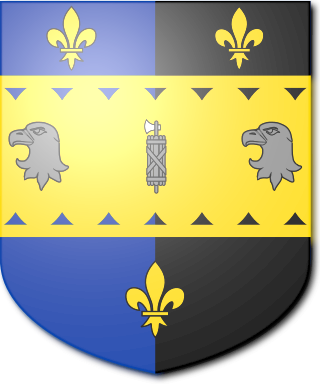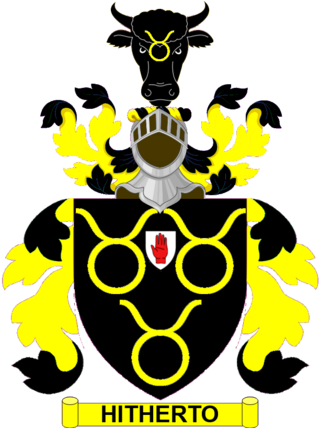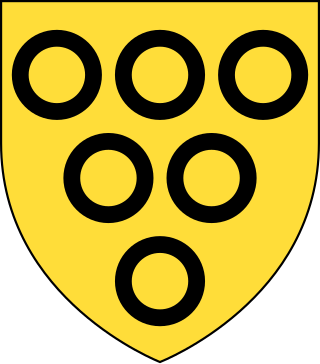
The Macara Baronetcy, of Ardmore in St Anne-on-the-Sea in the County of Lancaster, was a title in the Baronetage of the United Kingdom. It was created in 1911 for the Lancashire cotton-spinner, Charles Macara. The title became extinct upon the death of the fourth Baronet in Dudley in 1986.
The Duffbaronetcy, of Halkin in the County of Aberdeen, is a title in the Baronetage of the United Kingdom. It was created on 12 November 1813 for James Duff, British Consul in Cádiz, with remainder to his nephew, William Gordon.

The Ainsworth Baronetcy, of Ardnanaiseig in the County of Argyll, is a title in the Baronetage of the United Kingdom. It was created on 12 January 1917 for the industrialist, banker and Liberal politician John Ainsworth.
The Adair Baronetcy, of Flixton Hall in the County of Suffolk, was a title in the Baronetage of the United Kingdom. It was created on 2 August 1838 for Robert Adair. He was succeeded by his eldest son, the second Baronet. He sat as Member of Parliament for Cambridge. In 1873 he was created Baron Waveney, of South Elmham in the County of Suffolk, in the Peerage of the United Kingdom. The barony became extinct on his death in 1886 while he was succeeded in the baronetcy by his younger brother, Hugh Adair, the third Baronet. The latter had earlier represented Ipswich in Parliament. Two of his sons, the fourth and fifth Baronets, both succeeded in the title. The fifth Baronet's son, the sixth Baronet, was a major general in the British Army. The title became extinct on the latter's death in 1988.

The Whitehead Baronetcy, of Highfield House in Catford Bridge in the County of Kent, is a title in the Baronetage of the United Kingdom. It was created on 26 November 1889 for James Whitehead, Lord Mayor of London between 1888 and 1889 and later member of parliament for Leicester. His younger son, the third baronet, was also a Member of Parliament.

There have been two baronetcies created for members of the Whitmore family, one in the Baronetage of England and one in the Baronetage of the United Kingdom. One creation is extinct while the other is extant.

The Barrett-Lennard Baronetcy, of Belhus in the County of Essex, is a title in the Baronetage of the United Kingdom. It was created on 30 June 1801 for Thomas Barrett-Lennard, subsequently Member of Parliament for Essex South. He was the illegitimate son and testamentary heir of Thomas Barrett-Lennard, 17th Baron Dacre. He was succeeded by his grandson, the second Baronet, the son of Thomas Barrett-Lennard, Member of Parliament for Maldon. His son, the third Baronet, was childless and was succeeded by his younger brother, the fourth Baronet. This line of the family failed on the death in 1977 of his son, the fifth Baronet, who died without male issue. The late Baronet was succeeded by his third cousin once removed, the sixth Baronet. He was the son of Sir Fiennes Cecil Arthur Barrett-Lennard, Chief Justice of Jamaica, son of Captain Thomas George Barrett-Lennard, son of the first marriage of George Barrett-Lennard, son of John Barrett-Lennard, second son of the first Baronet. The sixth Baronet was a Catholic clergyman. As of 2014 the title is held by his second cousin, the seventh Baronet, who succeeded in 2007. He is the grandson of Trenchard Barrett-Lennard, son of the aforementioned George Lennard-Barrett by his second marriage. As of 31 December 2013 the present Baronet has not successfully proven his succession and is therefore not on the Official Roll of the Baronetage, with the baronetcy considered vacant since 2007.

The Chance Baronetcy, of Grand Avenue in the parish of Hove in the County of Sussex, is a title in the Baronetage of the United Kingdom. It was created on 19 June 1900 for James Timmins Chance, a grandson of William Chance, one of the Chance brothers who started the family business in 1771. He became head of Chance Brothers and Company. He was High Sheriff of Staffordshire in 1868.

The Bull Baronetcy, of Hammersmith in the County of London, is a title in the Baronetage of the United Kingdom. It was created on 25 November 1922 for the Conservative politician Sir William Bull. He represented Hammersmith and Hammersmith South in the House of Commons for many years. His eldest son, the second Baronet, died on active service in the Second World War and was succeeded by his younger brother, the third Baronet. As of 2019 the title is held by the latter's grandson, the fifth Baronet, who succeeded in 2019.
There have been four baronetcies created for persons with the surname Bell, all in the Baronetage of the United Kingdom. One creation is extant as of 2007.

The Pigot Baronetcy, of Patshull Hall in the County of Stafford, is a title in the Baronetage of Great Britain. It was created on 5 December 1764 for the politician and colonial administrator George Pigot, with remainder to his brothers General Robert Pigot and Admiral Hugh Pigot, and remains extant. On 19 January 1766 Pigot was further honoured when he was raised to the Peerage of Ireland as Baron Pigot, with normal remainder to the heirs male of his body. Lord Pigot was unmarried and on his death in 1777 the barony became extinct. He was succeeded in the baronetcy according to the special remainder by his brother, Robert, the second Baronet. He was a distinguished soldier.

The Milman Baronetcy, of Levaton-in-Woodland in the County of Devon, is a title in the Baronetage of Great Britain. It was created on 28 November 1800 for Francis Milman, Physician-in-Ordinary to King George III and President of the Royal College of Physicians. The seventh Baronet was a brigadier-general in the British Army.

The Smith, later Smith-Marriott Baronetcy, of Sydling St Nicholas in the County of Dorset, is a title in the Baronetage of Great Britain. It was created on 1 June 1774 for John Smith, High Sheriff of Dorset in 1772. The second Baronet married Elizabeth Anne, daughter of Reverend James Marriott. The fourth Baronet assumed by Royal sign-manual the additional surname of Marriott. The fifth Baronet was High Sheriff of Dorset in 1873.

The Crofton Baronetcy, of Mohill in the County of Leitrim, was created in the Baronetage of the United Kingdom on 10 August 1801 for Morgan Crofton. The sixth Baronet was a Lieutenant-Colonel in the 2nd Life Guards and fought in the Second Boer War, where he was severely wounded at the Relief of Ladysmith, and in the two world wars. His diaries from the First World War are published as Massacre of the Innocents: The Crofton Diaries, Ypres 1914–1915 (2004). Another member of the family, James Crofton, grandson of Morgan Crofton, third son of the first Baronet, was a Lieutenant-General in the Army.

The Stewart baronetcy, of Athenree in the County of Tyrone, was created in the Baronetage of the United Kingdom on 21 June 1803 for John Stewart. He was Attorney-General for Ireland from 1799 to 1803 and represented County Tyrone in the British House of Commons. The second Baronet also sat as Member of Parliament for County Tyrone. The sixth Baronet was Deputy Lieutenant of County Tyrone in 1971.

The Cholmeley baronetcy, of Easton in the County of Lincoln, was created in the Baronetage of the United Kingdom on 4 March 1806 for Montague Cholmeley, subsequently Member of Parliament for Grantham. His son, the second Baronet, sat as Member of Parliament for North Lincolnshire. He was succeeded by his son, the third Baronet, who also represented Grantham as MP. His grandson, the fifth Baronet, was High Sheriff of Lincolnshire in 1961 and a Vice-Lord-Lieutenant and Deputy Lieutenant of the county.

The Scott baronetcy, of Witley in the County of Surrey, was created in the Baronetage of the United Kingdom on 3 February 1913 for the naval commander Admiral Percy Scott.

The Bateman baronetcy, of Hartington in the County of Derby, was created in the Baronetage of the United Kingdom on 13 December 1806 for Hugh Bateman. The Batemans of Hartington Hall were the senior branch of the family; Sir Hugh had no sons, so the baronetcy was created with a special remainder allowing the male heirs of his two daughters to succeed. On 14 February 1815 his elder daughter Catherine Juliana married Edward Scott, and on 3 August the same year his younger daughter Amelia Anne married Sir Alexander Hood, 2nd Baronet, of St Audries.

The Reid baronetcy, of Ellon in the County of Aberdeen, was created in the Baronetage of the United Kingdom on 28 August 1897 for James Reid. He was physician to Queen Victoria, Edward VII and George V.

The Lowther baronetcy, of Swillington in the County of York, was created in the Baronetage of the United Kingdom on 3 November 1824 for John Lowther. He was the second son of Sir William Lowther, 1st Baronet, of Little Preston, and brother of William Lowther, 1st Earl of Lonsdale (1807). His seat was Wilton Castle.

















